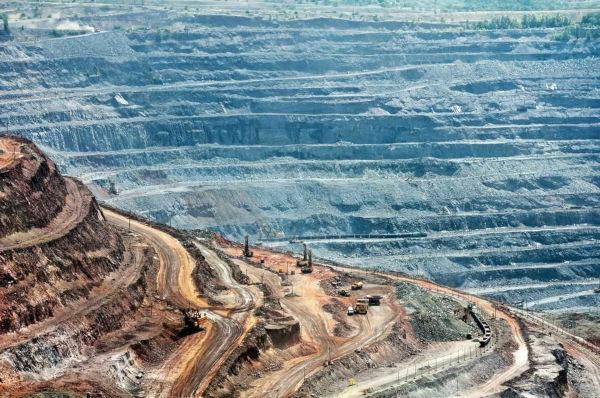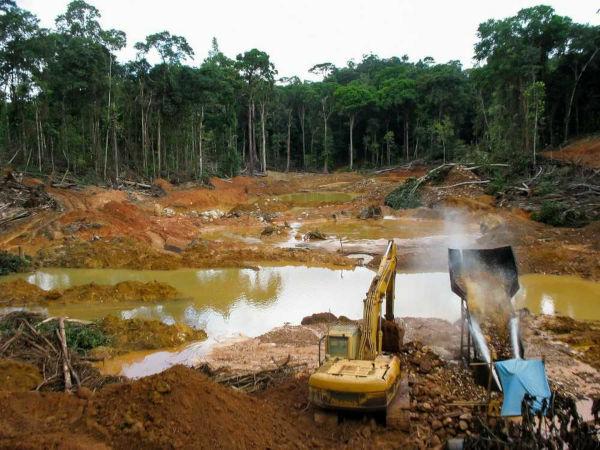There are many environmental impacts caused by mining, economic and industrial activity consisting of research, exploration, extraction and processing of ores present in underground deposits.
Despite being considered synonymous with socioeconomic development and being essential to society - considering that ores are found in virtually all consumer goods — the mining activity has a high potential for environmental impacts. As is the case with the pollution of water resources It's from ground, in addition to the loss of biodiversity both in relation to fauna and flora.
Read too: Anthropogenic actions in the environment
Do not stop now... There's more after the advertising ;)
Main environmental impacts generated by mining
According to the National Council for the Environment (Conama), the environmental impact is defined in article 1 of Resolution Conama-001 as: “[…] any change in the physical, chemical and biological properties of the environment caused by any form of matter or energy resulting from human activities that, directly or indirectly, affect the welfare and the health of the population; at socioeconomic activities; The biot; at aesthetic conditions and Sanitary of environment; and the quality of environmental resources.”
In mining, environmental impacts can be generated from project planning, through the stages of implementation, operation and deactivation. That is why it is necessary, before any implementation of the mining activity, to assess what are the possible negative impacts that can be caused to the environment in the area to be explored.
Read too:Environmental impacts of the accident in Mariana (MG)
These are the main environmental impacts caused by mining:
1) Landscape degradation
The most common mining in Brazil is the open pit. The exploration of ore in this way requires clearing a certain area and removing the fertile soil (also called sterile soil by mining companies, as it has a low ore content). The area is "cut" into blocks, which give the region a landscape full of "steps", thus modifying the entire landscape.
In order to carry out open pit mining, the first step refers to the removal of vegetation cover. Several areas are deforested, causing possible climate change and causing damage to fauna and flora.
Contamination of water resources can occur in three ways in mining:
- Through the high consumption of water for ore processing;
- By lowering the water table during the ore extraction stage, reducing the flow of water from rivers and also impacting the recharge of aquifers;
- Possible contamination of water through tailings with concentrations of toxic substances that are taken to the resources water through surface runoff or through the soil, which, by becoming contaminated, can also contaminate resources water. Iron, sand and granite mining, for example, can contaminate and pollute waters by the mud generated during the mining process. This mud needs to be contained by dams.
Read too: Disruption of the dam in Brumadinho
One of the stages of mining is the removal of fertile soil and its subsequent clipping. When leaving the ground bare, there may be loss of fertility and favoring its compression. During the extraction of ores, the soils can be contaminated, as is the case of lead and zinc mines, which have a high concentration of arsenic in their tailings. Some areas end up becoming unusable, as some substances can remain in the soil for a long time.
5) Noise pollution and air quality change
The preparation of areas for mining often takes place through explosions. Very compacted rock masses go through the dismantling process with the aid of explosives, causing noises that disturb biodiversity and often scare animals away from their areas. Another problem is changing the air quality. During the construction processes of the necessary infrastructure, as well as in the transport phase of ores, there are solid particle emission and pollutants to the atmosphere.
also know: Atmospheric pollution
6) Biodiversity reduction
Deforestation, noise pollution, as well as contamination and pollution of water and soil resources also cause the loss of biodiversity. Many animals lose their habitat and end up fleeing to other areas, as well as there is a loss of plant species in the region due to the removal of vegetation cover.
7) Reduced availability of minerals
In some mining areas, there is the total exhaustion of the extracted mineral resource, which makes them unusable.
8) Waste generation and inadequate disposal of tailings
THE tailings production (waste that is left over after processing the valuable ore) is not a problem as long as these are contained or relocated to recover areas. However, during the extraction phase, if not carried out correctly, these residues can reach the water resources, contaminating them.
Another problem is the volume of tailings deposits contained by dams, which, if not inspected, can rupture and have this volume transported to lower areas, reaching watercourses and polluting the environment. The volume of the deposit can also be a problem, when at a high level, as it can be carried by rainwater to other water resources.
What are tailings dams?
Basically, tailings dams are constructions formed by impermeable massive dams and with drainage devices, destined for the disposal of waste generated by the processing of ores (stage in which materials that have value are separated from those that will not be used).
Environmental impacts caused by iron mining

Iron mining causes changes in the landscape, deforestation and land devastation.
In Brazil, iron mining takes place mainly in the states of Minas Gerais (Central Quad), For (Serra do Carajá) and Mato Grosso do Sul (Massif of the Urucum). Brazil has large reserves of iron ore, which is one of the protagonists in the country's trade balance, especially in terms of exports, and China your biggest buyer. According to the Brazilian Mining Institute (Ibram), Brazil is the second bigger producer of ore in iron of the world. Reserves reach about 29 billion tons.
The main environmental impacts associated with iron mining are:
- Atmospheric pollution, due to the use of explosives in mines that emit polluting gases;
- Noise pollution, due to the explosions;
- Water pollution by mud generated and that requires the construction of dams to contain the tailings and, consequently, avoid chemical contamination of water resources and the soil.
O logging it is also a major environmental problem, especially in the areas of the Iron Quadrangle, in Minas Gerais. This region is covered by the Atlantic Forest biome, and part of the remaining areas of the Atlantic Forest belong to mining companies. In iron exploration areas, vegetation is removed to make room for open pit mining, also starting another environmental impact, the exposure of soils, which lose their fertility and are exposed to processes erosive. The Ministry of the Environment also points out problems in iron mining areas such as the presence of old containment dams, that can break and cause serious damage to the place where they are.
Read too:Deforestation and air pollution
Environmental impacts caused by gold mining

Gold mining causes pollution of water resources and soil through the use of mercury.
Gold mining, specifically in Brazil, takes place mainly in the states of Pará, Minas Gerais and Mato Grosso. The main impact caused by this activity is related to the mercury use in the mining process, which helps in the concentration of gold in the pan (a tool used in mining that helps in the search for ores).
O Mercury it has high volatility and can be oxidized and methylated. Thus, it becomes a toxic substance, which affects both humans and animals. Surface water runoff can also carry mercury to water resources, contaminating them and putting the ichthyofauna(set of fish existing in a region) and the water quality.
According to the Ministry of the Environment, the main environmental impacts caused by gold mining, in addition to the inappropriate use of mercury, are:
- Significant increase in water turbidity, especially in Minas Gerais. Water turbidity refers to the difficulty a beam of light encounters when passing through a quantity of water, due to the concentration of substances in it.
- The mining areas, especially in Minas Gerais, in the gold province of the Quadrilátero Ferrífero, present rejects rich in arsenic. Ore tailings with arsenic concentration were deposited on the banks of rivers, contaminating water resources and the soil.
Environmental impacts caused by mining in Minas Gerais
Minas Gerais is one of the richest states in minerals in Brazil, representing around 67% of the country's mineral reserves. According to the National Department of Mineral Production (DNPM), the state is the largest Brazilian producer of ores, representing around 47% of production.
Read more:Mining in colonial Brazil
The intense mining activity in the state goes against several environmental problems. Mining also causes contamination of water courses in the region and soil degradation. According to the report "Mining and the Environment in Brazil", prepared for the Center for Management and Strategic Studies, the main ores found in Minas Gerais associated with environmental impacts are the iron, O gold it's the limestone.
Disruption of the tailings dam in Brumadinho, Minas Gerais. (Image credit: Fire Department of Minas Gerais.)
In recent years, Minas Gerais has experienced two major impacts on the environment through mining. In 2015, the Fundão dam, owned by mining company Vale and controlled by Samarco Mineração, in the city of Mariana, which caused one of the greatest environmental impacts in the country. In 2019, a new dam failure, also by mining company Vale, left the city of little mist in Minas Gerais under mud of tailings, causing city destruction, hundreds of deaths, loss of biodiversity, pollution and Contamination water and soil resources.
By Rafaela Sousa
Graduated in Geography
